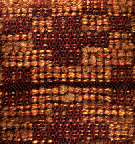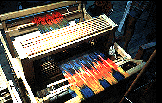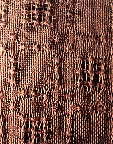

Is the structure of the weave Simple or Compound?
Simple weave: Only one set of warp and weft pathway types
 Compound
weave: Any type of woven structure which involves more than two sets
of elements - such as one (or more) warp sets, plus two (or more) weft
sets, which are manipulated through different pathways to create a pattern.
Compound
weave: Any type of woven structure which involves more than two sets
of elements - such as one (or more) warp sets, plus two (or more) weft
sets, which are manipulated through different pathways to create a pattern.
Design: Plain or pattern weave?
Plain weave: Warp/weft pathways are over/under every other thread
Pattern weave: Wefts "float" over or under groups of warps in a logical sequence that creates a pattern.
Weft (or warp) pathway: Continuous or Discontinuous?
Continuous wefts travel from edge to edge of the cloth (use of a shuttle, typical of most conventional cloth)
Discontinuous wefts do not travel from edge to edge, but only in small areas where they are needed for the design (tapestry or inlay designs).
Other terms describing structural design in textiles:
Felt: Wool fibers that have been agitated, and exposed to moisture, heat, and cold, until the fibers randomly interlock to form a solid mass. Among natural fibers, only wool fibers can be felted, because of their distinctively scaly structure. This link will take you to a site that will show you how felt is made.
Floats (or pattern floats): Weft threads that create a pattern by passing over (and covering) clusters of warp threads in a planned sequence (or vice versa).
Ikat: The wrapping or covering of areas of a warp or weft prior to weaving in order to create a dyed design in the threads. This link will take you to other examples of ikat and some pictures of the process.
Knotted pile weave: Plain weave which alternates with rows of knots tied to the warp to form a pile surface; typically used to make pile carpets.
 Loom:
A device for holding a set of threads or yarns in sequence, parallel, and under
tension (the warp) so that other yarns may be interlaced with them at
right angles (weft). This process of interlacing warp and weft
yarns on a loom is called weaving.
Loom:
A device for holding a set of threads or yarns in sequence, parallel, and under
tension (the warp) so that other yarns may be interlaced with them at
right angles (weft). This process of interlacing warp and weft
yarns on a loom is called weaving.
Nonwoven interlacing techniques: knitting, crochet, netting, lace
techniques.
Plain weave or "Tabby" weave: Simple weave structure in which the weft passes over and under every other thread.
 Simple
weave: Any type of woven structure which involves only two sets of
elements - one warp set and one weft set.
Simple
weave: Any type of woven structure which involves only two sets of
elements - one warp set and one weft set.
 Tapestry
weave: Plain weave with discontinuous wefts of different
colors used to created a visual design or picture. Usually the weft covers
the warp.
Tapestry
weave: Plain weave with discontinuous wefts of different
colors used to created a visual design or picture. Usually the weft covers
the warp.
 Twill
weave: Simple weave structure in which the weft floats
over and under specified number of warps in each row, but shifts over
one place in each subsequent row, creating a diagonal pattern.
Twill
weave: Simple weave structure in which the weft floats
over and under specified number of warps in each row, but shifts over
one place in each subsequent row, creating a diagonal pattern.
Warp: A set of yarns that are held in sequence, parallel, and under
tension, so that other yarns (weft) can be interlaced with them to make cloth.
Weft: Yarns that are interlaced with warp yarns at right angles to make cloth. Weft is usually wound on a shuttle or bobbin which is then passed between alternating layers of warp threads.

|